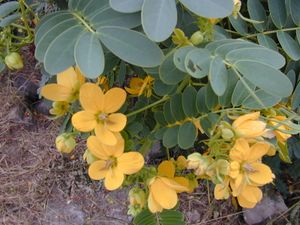Note: This is a project under development. The articles on this wiki are just being initiated and broadly incomplete. You can Help creating new pages.
Senna siamea - Siamese Senna
Senna (from Arabic sanā), the sennas, is a large genus of flowering plants in the legume family Fabaceae, and the subfamily Caesalpinioideae. This diverse genus is native throughout the tropics, with a small number of species in temperate regions. The number of species is estimated to be from about 260 to 350. The type species for the genus is Senna alexandrina. About 50 species of Senna are known in cultivation.
Medicinal uses
- Likely Effective for:
Constipation. Taking senna by mouth is effective for short-term treatment of constipation. Senna is an FDA-approved nonprescription drug for adults and children ages 2 years and older. However, in children ages 3-15 years, mineral oil and a medication called lactulose might be more effective than taking senna. Senna also appears to be effective for treating constipation when used in combination with psyllium or docusate sodium. In elderly people, senna plus psyllium is more effective than lactulose for treating ongoing constipation. Senna plus docusate sodium is effective for treating constipation in the elderly and in people who have undergone anorectal surgery. Taking senna appears to be as effective as lactulose, psyllium, and docusate for relieving constipation in people taking opioids or loperamide.
- Possibly Effective for:
Bowel preparation before colonoscopy. Taking senna by mouth is as effective as castor oil and bisocodyl for bowel cleansing. Some evidence suggests that senna is also at least as effective as polyethylene glycol for bowel preparation. However, conflicting evidence exists. It is unclear if taking senna with polyethylene glycol is more effective than taking polyethylene glycol alone. Senna appears to be less effective than sodium phosphate for bowel cleansing. However, taking a combination of senna, sodium picosulfate, and polyethylene glycol appears to be more effective than sodium phosphate for bowel prepration prior to colonoscopy.
- Possibly Ineffective for:
Diagnostic imaging. Taking senna by mouth does not appear to improve imaging of abdominal organs.
- Insufficient Evidence for:
Hemorrhoids. Irritable bowel disease. Losing weight.
